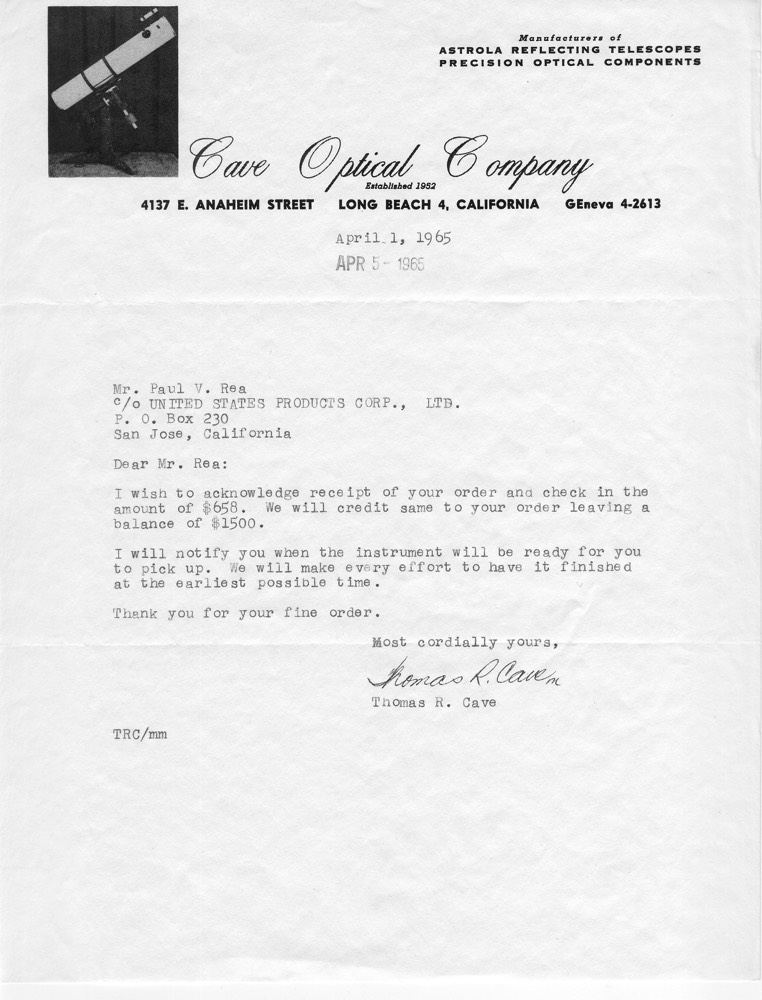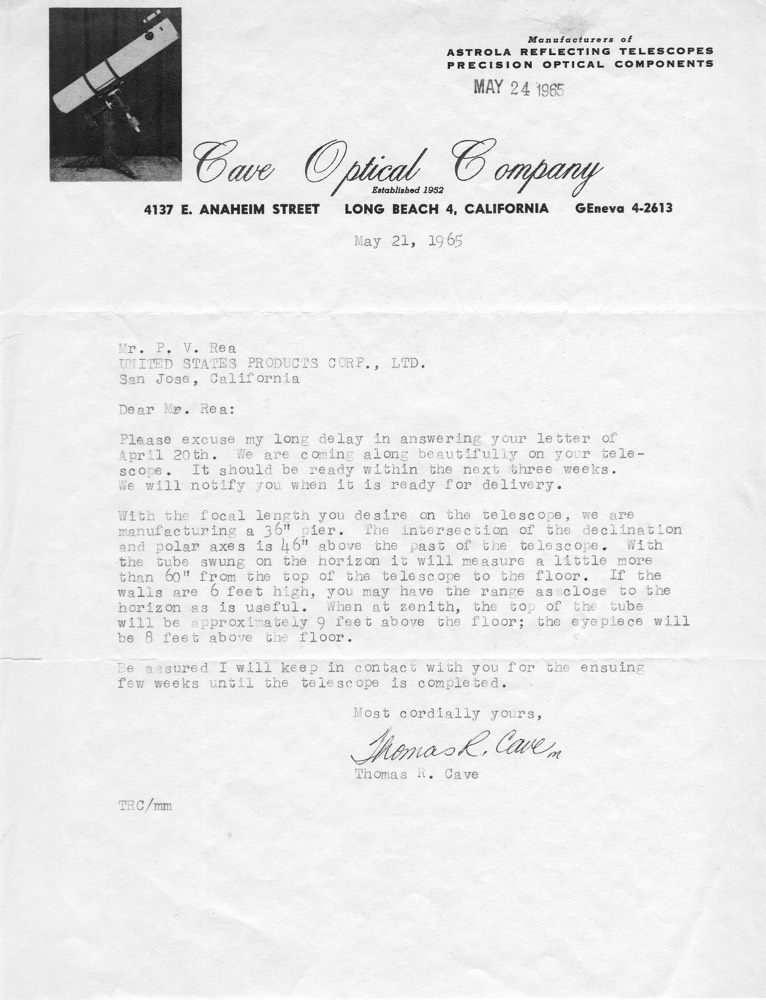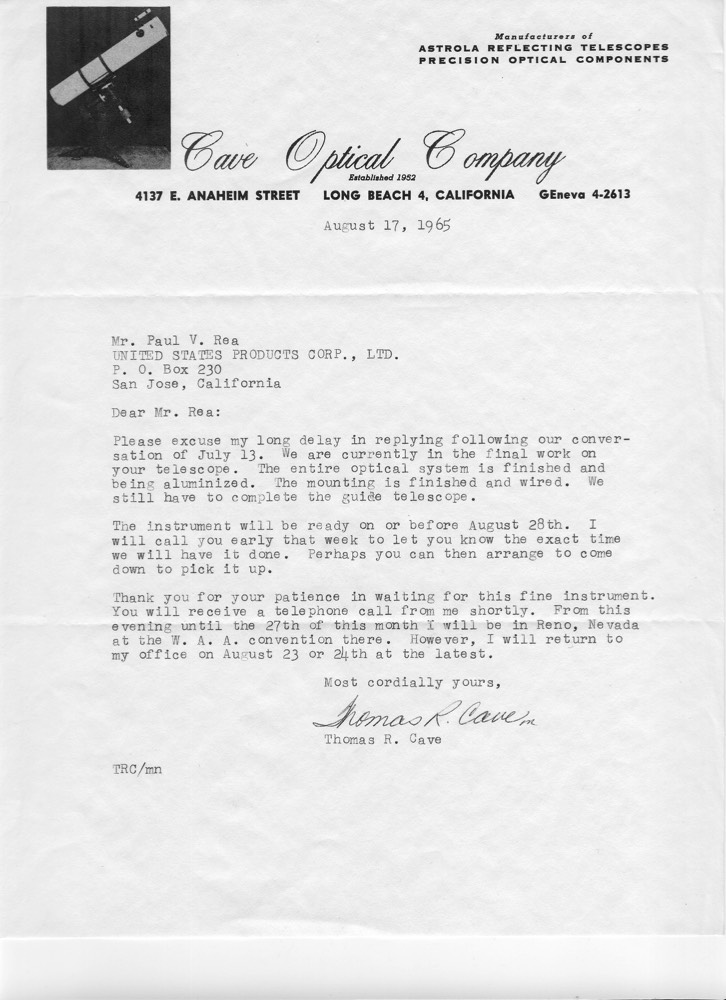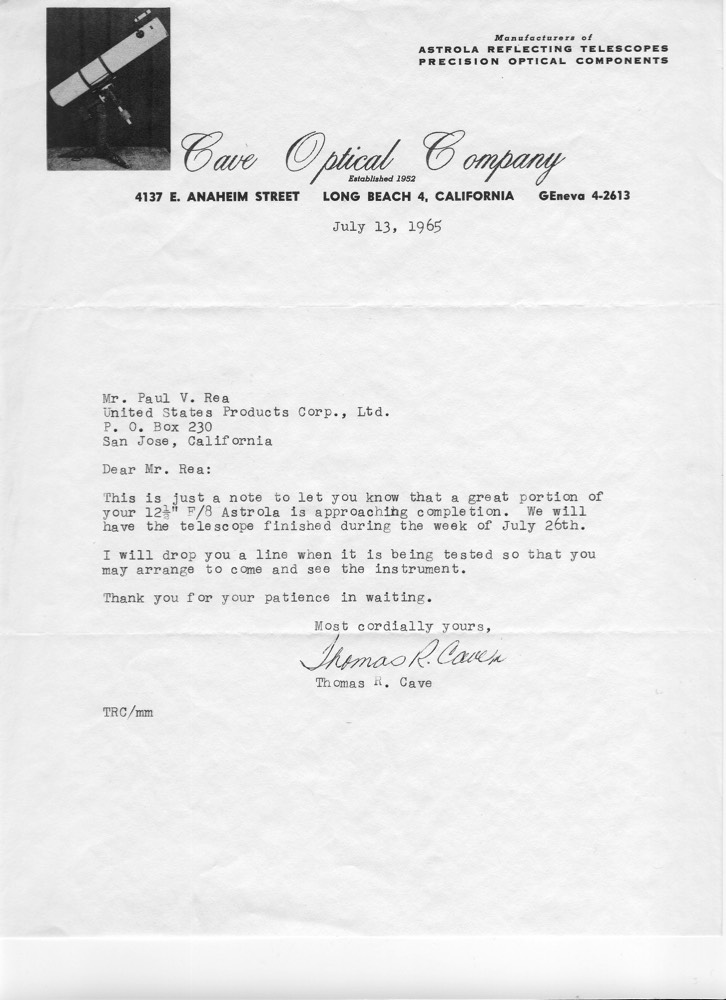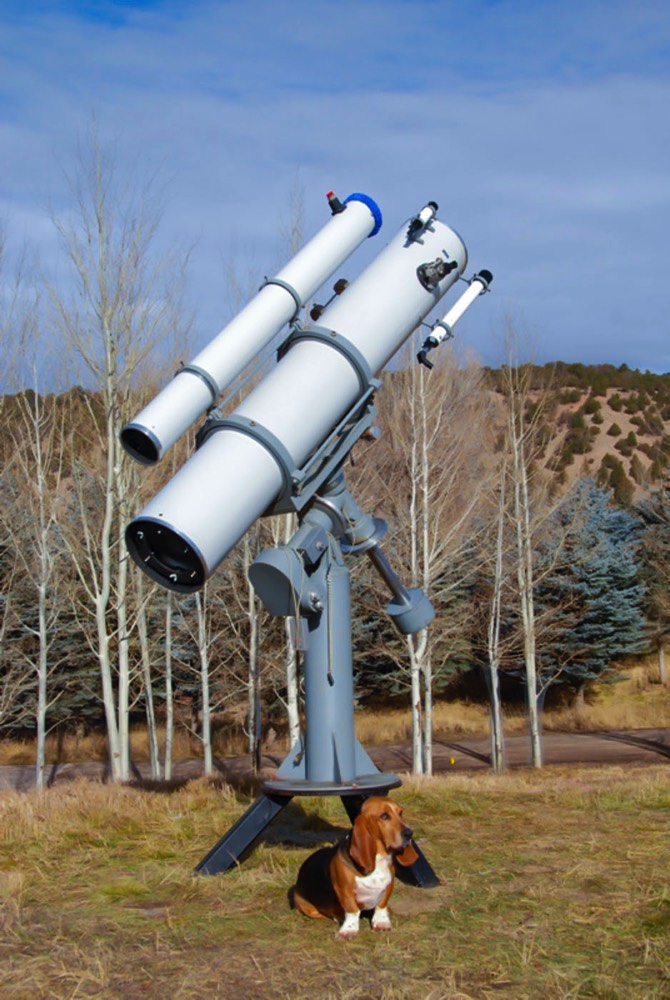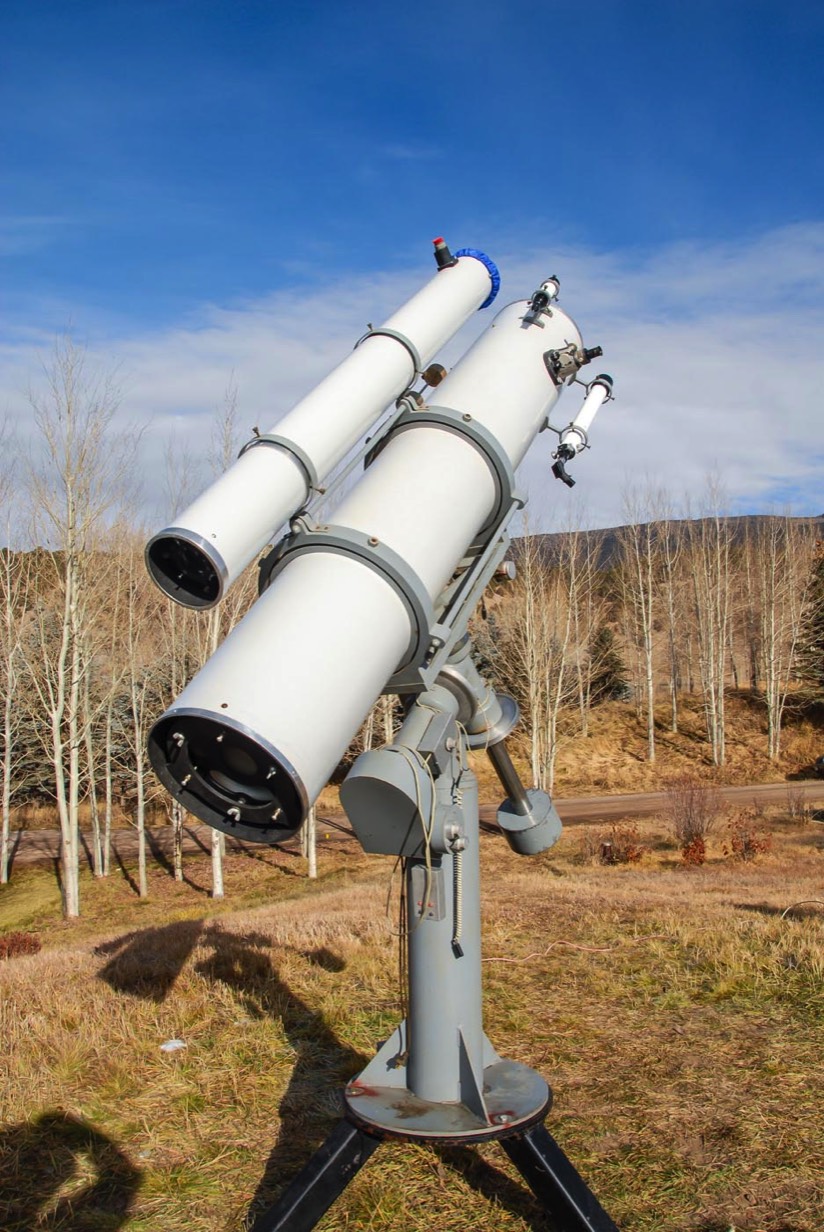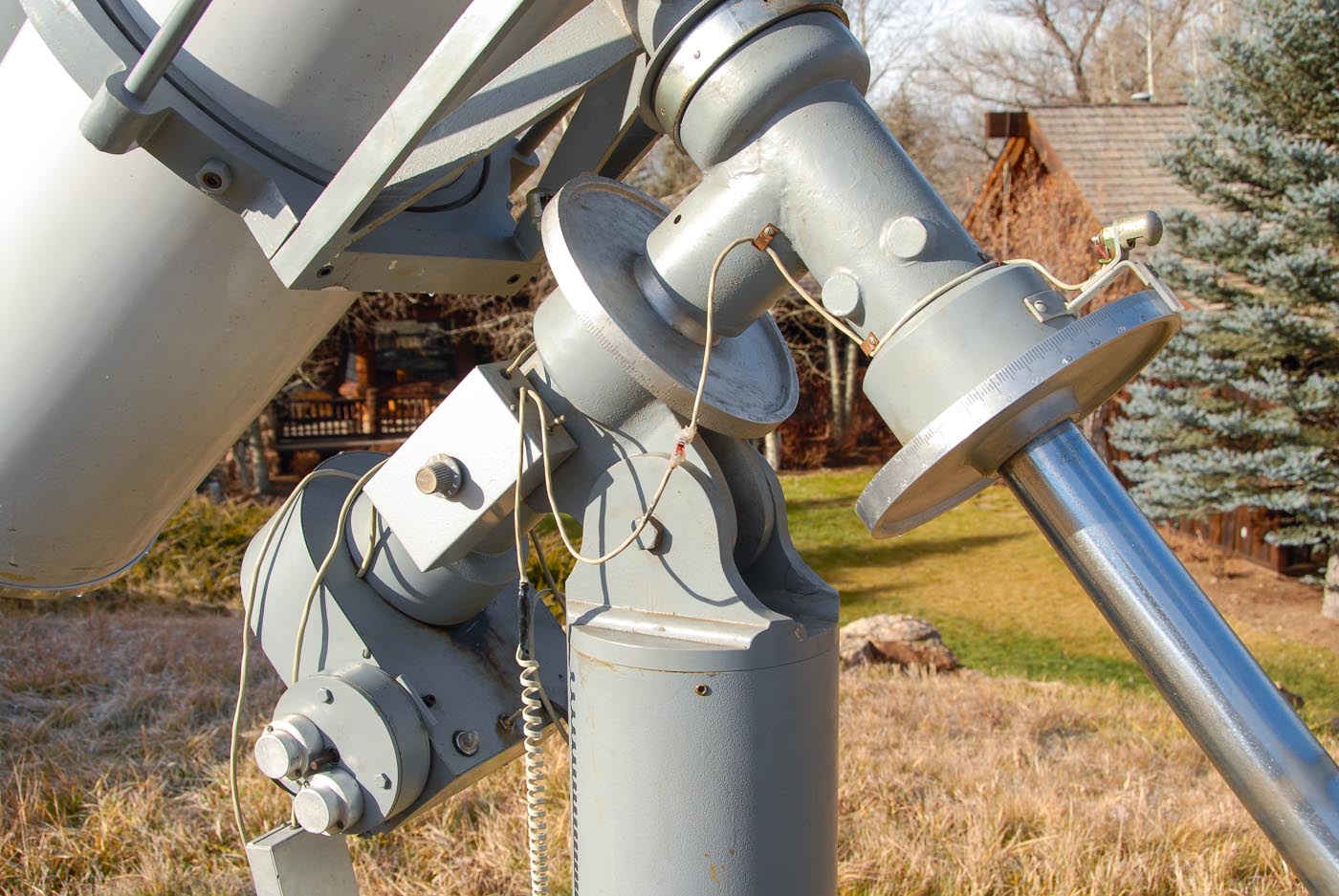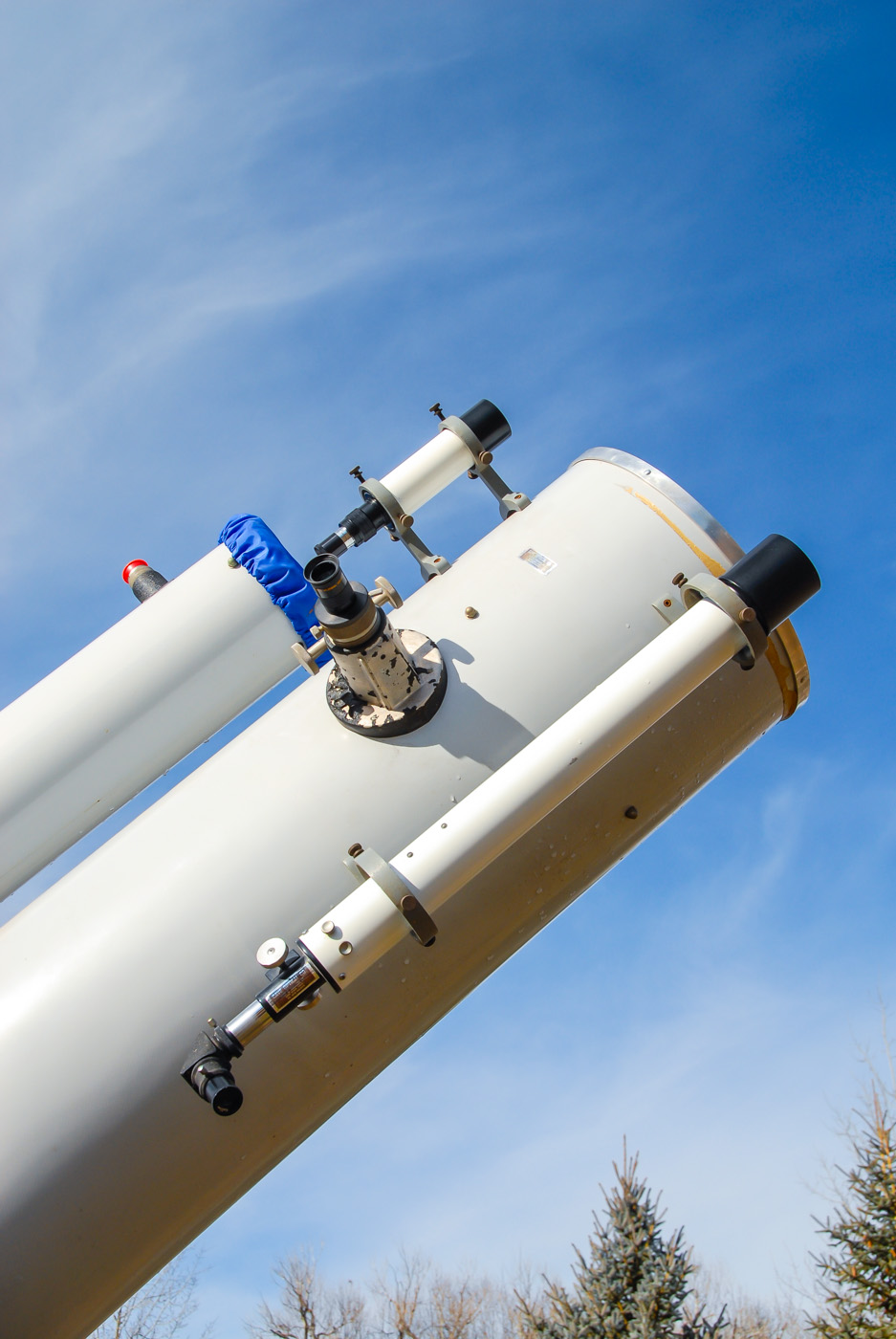A Tale of Two 12 1/2-inch Observatory Model D's
John W. Briggs
HUT Observatory
Eagle, Colorado
In what now seems like beyond a lifetime ago, as a young teenager back in '72 and '73, it was my privilege to attend a fabulous summer astronomy program called Camp Uraniborg. It started in Rhode Island as the brainchild of Joe Patterson, a recent Harvard graduate who had a vision for teaching science in a creative and hands-on way. Camp Uraniborg ran in 4-week July and August sessions for a group of about 25 students. The program ran seemingly 24 hours a day, with morning science lectures and afternoon telescope making, including optical fabrication and testing. Nighttime observing continued afterward, going as late as clear skies and teenage endurance would allow. Along the way, we were exposed to computer programming, astrophotography, film and print development, lasers, and even holography. The key to success was that the students were self-selected & enthusiastic, and the staff was profoundly dedicated & energetic. The program was advertized through the pages of Sky & Telescope magazine, but I found out about it luckily, through a mailing to the Greater New Bedford Astronomical Society.

The Paul V. Rea 12 1/2-inch f/7.3 telescope as set up temporarily near Eagle, Colorado, by John W. Briggs in late November 2013. The stout steel tripod behind the Basset hound was made for another telescope but served well as a temporary foundation for the Cave equatorial observatory model D.
The telescopes made the biggest impression on me. Among many instruments, there were at least two 10-inch Caves in 1972, as well as a 12.5-inch observatory Dynascope in a roll-off roof that was dedicated to photoelectric photometry. That year the Camp operated on the campus of Portsmouth Abbey School. The whole group jumped in a bus for the total solar eclipse in Canada, and again later for the Stellafane convention in Vermont. Altogether this was an absolutely fantastic, somewhat improvised and free form sleeping-bag experience, powered by the simplicity of hot dogs, potato chips, and what we called "Uraniburgers." Highlighting August were spectacular displays of northern lights seen from both Rhode Island and Stellafane.
Many of the same students and staff returned in 1973. Uraniborg had relocated to a remote desert location near Newberry Springs, California, about 30 miles east of Barstow. The environment was alien but wonderful to a Massachusetts kid like me, with lizards, cactus, large green scorpions, occasional rattlesnakes (which would be shot), and daytime temperatures as hot as 114 degrees. But the starry sky was as dark and clear as I'd ever seen it before, night after night. During the day, we made mirrors. Older students taught the younger in occasional lectures. I remember being thoroughly boggled by Newton's law of universal gravitation, the equation seeming so complex. The problem was that I had not yet seen algebra. The older kid leading the discussion was David Targan, now Director of Brown University's Ladd Observatory.
Many of the same students and staff returned in 1973. Uraniborg had relocated to a remote desert location near Newberry Springs, California, about 30 miles east of Barstow. The environment was alien but wonderful to a Massachusetts kid like me, with lizards, cactus, large green scorpions, occasional rattlesnakes (which would be shot), and daytime temperatures as hot as 114 degrees. But the starry sky was as dark and clear as I'd ever seen it before, night after night. During the day, we made mirrors. Older students taught the younger in occasional lectures. I remember being thoroughly boggled by Newton's law of universal gravitation, the equation seeming so complex. The problem was that I had not yet seen algebra. The older kid leading the discussion was David Targan, now Director of Brown University's Ladd Observatory.
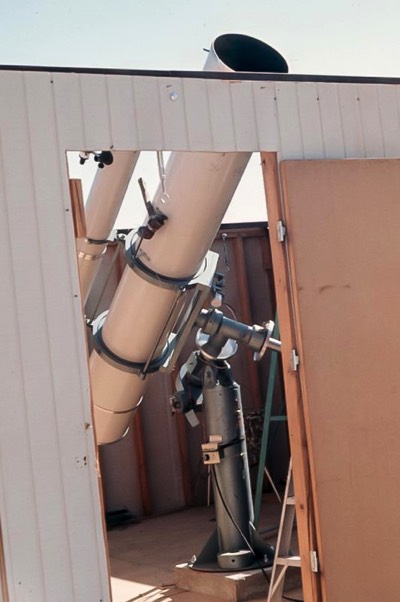
The 12 ½” f/8 Model D Observatory Cave Astrola Newtonian, at Camp Uraniborg, Newberry Springs, California, 1973. Photograph by camper Bryan Biggers. Some remember it as an f/9.
The Uraniborg Astrola
Along with many smaller telescopes, Uraniborg instrumentation in 1973 included a Celestron 14, an early homemade 16-inch Dobsonian, and a 12 1/2-inch f/8 Model D Observatory Cave Astrola. Although the Celestron was supposed to be the leading instrument, it was the massive Cave that impressed me most. It was a classic example, with all the standard features of the Observatory Model D, including illuminated 10-inch setting circles, 2 1/2-inch axles, a huge rotating tube, a Sky-Micro Giant 2-inch focuser, and a long-focus 6-inch guide Newtonian. Back then; I did not worry about more subtle issues, like the question of differential flexure. But have no matter. Because there was no question that the big Cave, in its simple flat-roof enclosure, was incredibly cool, and its function was terrific as a basic, visual instrument. To me at the time, it seemed about the coolest telescope imaginable. I never forgot it.
I've taken time to explain Camp Uraniborg because it's surprising how a large percentage of its participants, both students and staff, continued in astronomy or optics, either as serious amateurs or as professionals. My roommate in the desert, for example, was Neil Tyson, who went on through Harvard and graduate school and is now one of the most well known spokesmen of science in the country.
.
Currently Neil lists 17 "selected" of his honorary PhD's on his Wikipedia site! One could go on talking about him and other Uraniborgers, but it would get too far away from our interest here in Cave telescopes. However, as we try to explain the wonder and joy of these instruments to friends and spouses, it's useful to point out how, in the right circumstances, these instruments could be a profound inspiration. The examples connected with Uraniborg are the best I know.
Sadly, Patterson's Uraniborg lasted only one more year. It relocated away from the extremes of the Mojave, setting up in 1974 at Camp Oaks, near Big Bear Lake (and the famous Solar Observatory), also in California. However, in making this final move, the Camp had a huge, if indirect, influence on amateur astronomy at a national level. Clifford W. Holmes, organizer of Riverside Telescope Makers Conference, visited Uraniborg at Camp Oaks and decided to move the annual Conference to the same site. For many years afterwards RTMC at Camp Oaks was a profoundly influential and educational event, drawing thousands to its annual Memorial Day Weekend campout. At the same time Holmes discovered Camp Oaks, Joe Patterson was becoming fully absorbed in graduate school. He and his staff realized the Camp could not continue. When I saw the Camp's equipment being sold in a Sky Gazer's Exchange ad in Sky & Telescope, I was horrified. I realized it meant the program was folding, and I, having skipped a year to save money, would now never be able to return. That was early in my 10th grade. As best I understand, the big Cave was sold to a member of the China Lake Astronomical Society in California. It fate today is unknown.
Joe Patterson went on to become a professor at Columbia, where Neil Tyson finished his PhD. I became an engineer based at Yerkes Observatory for 13 years. David Targan reactivated a new Uraniborg at St. Cloud State University in Minnesota that ran in the early 1980s. Several times over the decades I drove back to desert site of Uraniborg '73, where one can still see in the ground the cement blocks and anchor bolts for the Cave, the Celestron, and other instruments. The sense of nostalgia was strong. And although I used a lot of other telescopes over the years, I never got to use, or even see, another Cave 12 1/2-inch Observatory Model D. That is, until last year, when I saw an ad on the Astromart website.
The Paul V. Rea Astrola
Paul V. Rea was a fruit-canning executive in San Jose, California. On April 1, 1965, Thomas R. Cave acknowledged his order for a 12 1/2-inch permanent observatory model D, for a total price of $2,158. Rea had prepaid $658. Cave promised the instrument would be ready at the earliest possible time. On May 21, Cave wrote that it would be ready within three weeks. This, however, proved overly optimistic. On July 13, Cave promised that the f/8 would be ready during the week of July 26. In the end, it was not until August 28 that the telescope was finally complete.
Sadly, Patterson's Uraniborg lasted only one more year. It relocated away from the extremes of the Mojave, setting up in 1974 at Camp Oaks, near Big Bear Lake (and the famous Solar Observatory), also in California. However, in making this final move, the Camp had a huge, if indirect, influence on amateur astronomy at a national level. Clifford W. Holmes, organizer of Riverside Telescope Makers Conference, visited Uraniborg at Camp Oaks and decided to move the annual Conference to the same site. For many years afterwards RTMC at Camp Oaks was a profoundly influential and educational event, drawing thousands to its annual Memorial Day Weekend campout. At the same time Holmes discovered Camp Oaks, Joe Patterson was becoming fully absorbed in graduate school. He and his staff realized the Camp could not continue. When I saw the Camp's equipment being sold in a Sky Gazer's Exchange ad in Sky & Telescope, I was horrified. I realized it meant the program was folding, and I, having skipped a year to save money, would now never be able to return. That was early in my 10th grade. As best I understand, the big Cave was sold to a member of the China Lake Astronomical Society in California. It fate today is unknown.
Joe Patterson went on to become a professor at Columbia, where Neil Tyson finished his PhD. I became an engineer based at Yerkes Observatory for 13 years. David Targan reactivated a new Uraniborg at St. Cloud State University in Minnesota that ran in the early 1980s. Several times over the decades I drove back to desert site of Uraniborg '73, where one can still see in the ground the cement blocks and anchor bolts for the Cave, the Celestron, and other instruments. The sense of nostalgia was strong. And although I used a lot of other telescopes over the years, I never got to use, or even see, another Cave 12 1/2-inch Observatory Model D. That is, until last year, when I saw an ad on the Astromart website.
The Paul V. Rea Astrola
Paul V. Rea was a fruit-canning executive in San Jose, California. On April 1, 1965, Thomas R. Cave acknowledged his order for a 12 1/2-inch permanent observatory model D, for a total price of $2,158. Rea had prepaid $658. Cave promised the instrument would be ready at the earliest possible time. On May 21, Cave wrote that it would be ready within three weeks. This, however, proved overly optimistic. On July 13, Cave promised that the f/8 would be ready during the week of July 26. In the end, it was not until August 28 that the telescope was finally complete.
Click on a page to zoom in.
Rea housed the instrument in an Ash dome at his home not far off Alum Rock Road, which connects from San Jose up toward Lick Observatory. Although we cannot be sure, there's no indication that Rea used the instrument much. A neighbor recalled that he also built a well-equipped wood and metal shop at his house, but he did not appear to have built anything afterwards. The home was eventually sold to Ray and Ellen Turner. They loved the site but were not astronomers. In fact, they did not lay eyes on the telescope before they bought the house, as the real estate agent did not have a key to the windowless observatory. After some years, they discovered Astromart as a forum for selling specialized equipment, and thinking that the telescope should go to someone who would appreciate it, in 2012 they sold it to Larry Thaxton, a well-known amateur astronomer in Los Angeles. Larry registered the 1965 mirror on the Cave Registry, serial M 651543, noting that the as-built focal ratio is f/7.3.
It was not until after the sale to Larry that I happened to see the ad on Astromart. It was clear that the instrument in question was amazingly similar to my memories from Camp Uraniborg. I was able to contact Larry and explain my interest. He had owned and used a large number of diverse instruments, and he appreciated my enthusiasm. As he already had another telescope quite similar to the Rea instrument, he was willing to pass the Rea to me at a very reasonable price. It thus became mine -- an instrument essentially twin to the one that had impressed me so, 40 years earlier!
Living in Eagle, Colorado, and being busy, I wasn't able to move the telescope right away. Thus I made arrangements for it to be stored with the help of friends at Mount Wilson Observatory, and it went into the rear area of the Snow horizontal telescope enclosure. By November of 2013, however, I was able to move it to Colorado, I set it up using a heavy and stable tripod weldment that I'd made a decade ago for the 5-inch Abbot Academy telescope (an Alvan Clark & Sons refractor from 1875). The Rea telescope was thus assembled in hope it could be used for public programs in downtown Eagle to show off Comet ISON. Described in media as Comet of a Lifetime, the object proved, for the public at least, to be Comet Flop. Setting up and testing the 12 1/2" was nevertheless useful and exciting. The base tripod worked great as a temporary foundation, and the light, tent-like pop-up shelter proved practical. Thus, for special events, the telescope can be set up and used for a few days at a time as an impressive working display. The reality of it is much larger and more imposing than suggested by these photos, by the way. Carried on the tripod foundation, the instrument stands nearly 11 feet above ground.
It was not until after the sale to Larry that I happened to see the ad on Astromart. It was clear that the instrument in question was amazingly similar to my memories from Camp Uraniborg. I was able to contact Larry and explain my interest. He had owned and used a large number of diverse instruments, and he appreciated my enthusiasm. As he already had another telescope quite similar to the Rea instrument, he was willing to pass the Rea to me at a very reasonable price. It thus became mine -- an instrument essentially twin to the one that had impressed me so, 40 years earlier!
Living in Eagle, Colorado, and being busy, I wasn't able to move the telescope right away. Thus I made arrangements for it to be stored with the help of friends at Mount Wilson Observatory, and it went into the rear area of the Snow horizontal telescope enclosure. By November of 2013, however, I was able to move it to Colorado, I set it up using a heavy and stable tripod weldment that I'd made a decade ago for the 5-inch Abbot Academy telescope (an Alvan Clark & Sons refractor from 1875). The Rea telescope was thus assembled in hope it could be used for public programs in downtown Eagle to show off Comet ISON. Described in media as Comet of a Lifetime, the object proved, for the public at least, to be Comet Flop. Setting up and testing the 12 1/2" was nevertheless useful and exciting. The base tripod worked great as a temporary foundation, and the light, tent-like pop-up shelter proved practical. Thus, for special events, the telescope can be set up and used for a few days at a time as an impressive working display. The reality of it is much larger and more imposing than suggested by these photos, by the way. Carried on the tripod foundation, the instrument stands nearly 11 feet above ground.
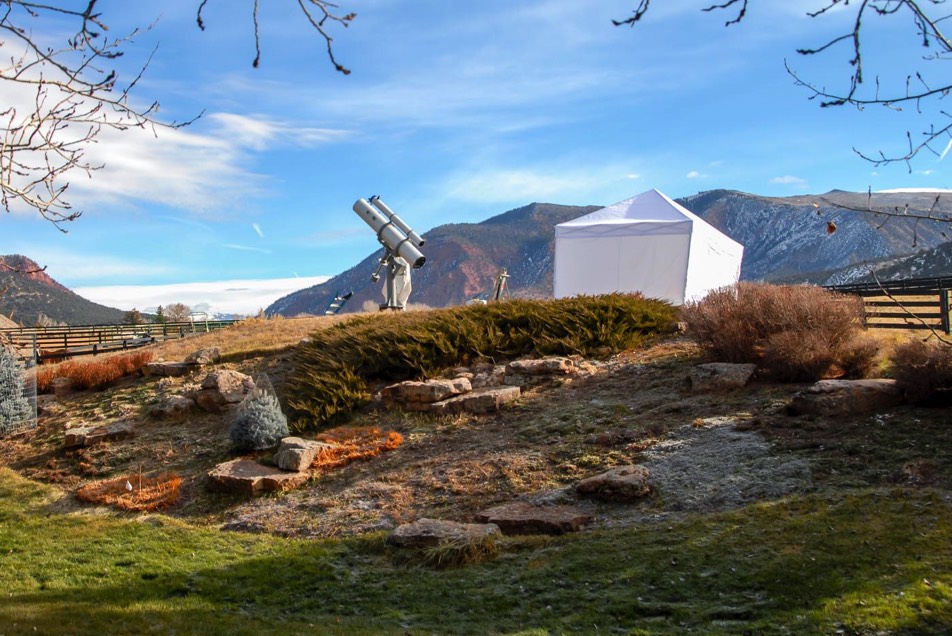
There was only one night with reasonably good seeing before incoming poor weather forced disassembly. But the air was stable enough that, with high power, stellar Airy disks and diffraction rings were seen with reasonable confidence, as I had dearly hoped. Thus all indications are that the telescope should be a "planet killer" when it's set up in good seeing with freshly recoated mirrors.
The instrument is in excellent and original condition for its 48-year age, having never been repainted or mechanically modified in any way, except for very minor replacement of some original cabling for the setting circle lights. I'm inclined to keep it as original as possible.
The instrument is in excellent and original condition for its 48-year age, having never been repainted or mechanically modified in any way, except for very minor replacement of some original cabling for the setting circle lights. I'm inclined to keep it as original as possible.
I was surprised to discover that the one-piece declination counterweight appears to be machined entirely from a cylinder of lead. Even so, its outer flat surface must be placed somewhat beyond the end of the 2 1/2-inch diameter axle. The declination axle was drilled slightly in one spot at the factory to receive the counterweight's locking setscrew. While not elegant, the general use of setscrews in many locations was standard for Cave.
The images of various Cave telescopes as shown in advertisements and catalogues through the years are iconic for American amateur astronomy during the Space Race. In other words, I believe many of us grew up simply ogling these images. The Cave catalogue that survived with the Rea telescope papers is a version showing an earlier design for the 12 1/2-inch observatory model D. The next catalogue issued appears to use an image of the Rea instrument, recorded before the telescope left the shop, to illustrate the model class. While I haven't made measurements yet between the catalogue photo and my own of the Rea, I expect that various distance ratios involving the tube lengths, the position of the finders, and the position of the declination counterweight, will prove that the Rea and the later catalogue image are one-and-the-same.
My family and I expect the Rea telescope will be housed in a roll-off roof observatory at a dark-sky site we own in New Mexico. It will please us to hear from folks who are interested to come use this instrument -- a classic from a golden age of visual American amateur astronomy at the height of the Space Race. I'm hoping some old friends from Camp Uraniborg just might show up! Cheers--
--John W. Briggs.
http://hutobservatory.com/john-w-briggs/
--John W. Briggs.
http://hutobservatory.com/john-w-briggs/
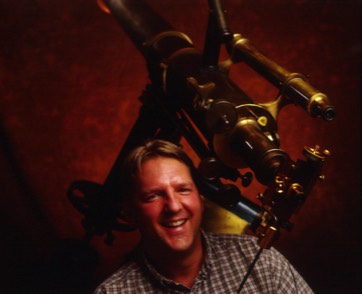
Thanks very much John for your article and your love for the classic telescopes!
. . . Tom T

